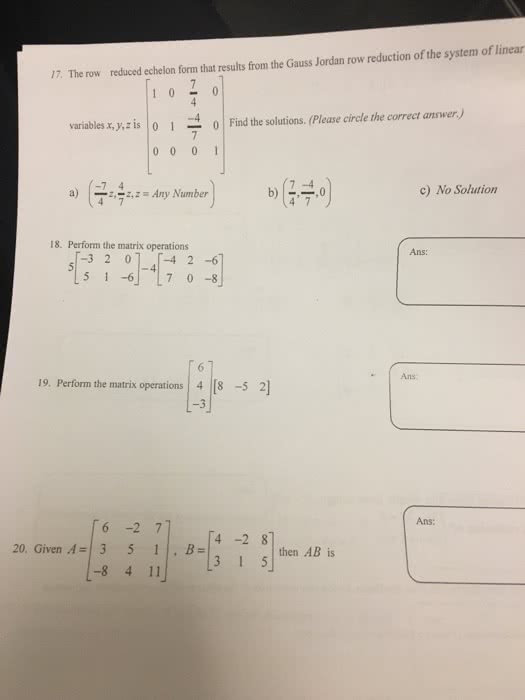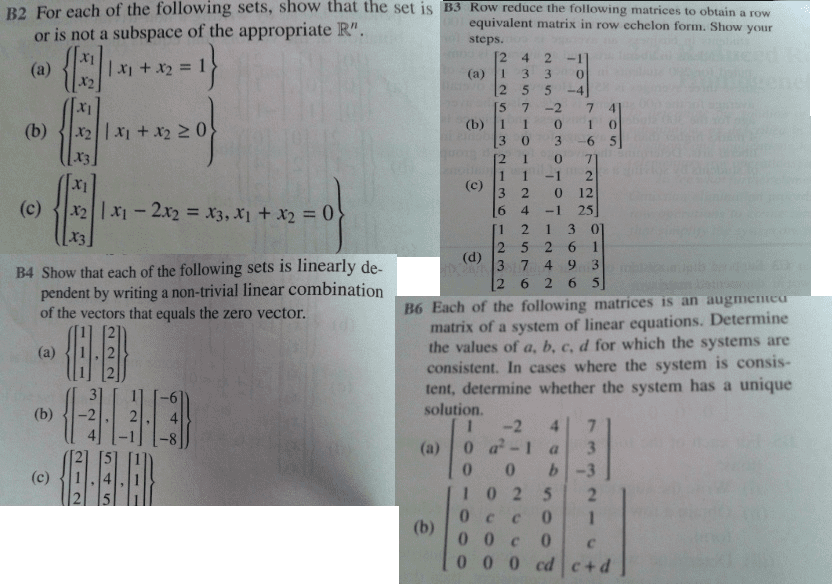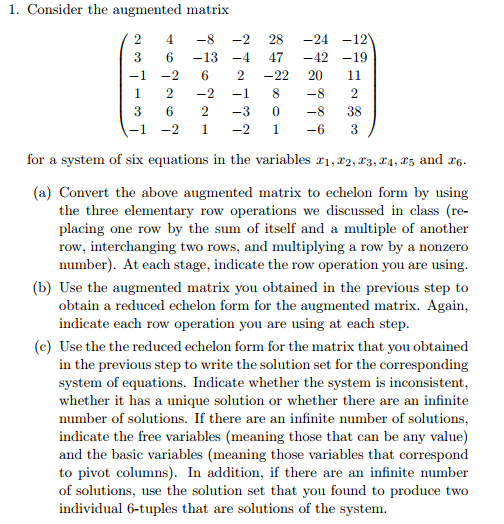18.03 Lecture Notes - Lecture 1: Row Echelon Form, Elementary Matrix, Gaussian Elimination

Solving Linear Systems
Objectives
!Understand matrix row operations and now they relate to equation operations for systems
!Understand how to find the pivots of a matrix and how to put a matrix in row-echelon form
!Be able to solve a system of linear equations using Gauss-Jordan elimination
Balancing a Chemical Reaction: Linear Systems in Matrix Form
!Suppose that we need to find the smallest positive integers a, b, c, d that balance the reaction
!The constraint that the number of nitrogen atoms on the LHS and RHS of the reactions must be equal gives use the
! constraint that a = c + d, which we can write as 0 = a - c - d. Similarly the same constraint on the oxygen and hydrogen atoms
! yield the equations 2a + b - 2c - 3d = 0 and 2b - c - d = 0
!!
!!These equations constitute a linear system:
!!
!!Any linear system can be written in matrix form Ax = b
!A linear system is homogeneous if the RHS are all zero and inhomogeneous otherwise
!A linear system is consistent if it has at least one solution and inconsistent if there are no solutions
Equation Operations and Row Operations
!A good way to solve a linear system is to perform the following operations repeatedly
!!- multiplying an equation by a nonzero number
!!- interchanging two equations
!!- add a multiple of one equation to the other equation
!The solution set is unchanged at each set
!Equation operations correspond to the operations on the augmented matrix, called elementary row operations:
!!- multiplying a row by a nonzero number
!!- inteR changing two rows
!!- add a multiple of one row to another row
Row-Echelon Form and Pivots
!Steps to solve a linear system Ax = b:
!!- use row operations to convert the augmented matrix to a particular simple form, called row-echelon form
!!- solve the enw system by back-substitution
Definition of Row-Echelon Form
!A matrix is in row-echelon form if it satisfies both of the following conditions:
!!- all of the zero rows (if any) are grouped at the bottom of the matrix
!!- each pivot lies father to the right of the pivots in the higher rows
Gaussian Elimination
!Gaussian elimination is an algorithm for converting any matrix into row-echelon form by performing row operations
!!- Find the leftmost zero column, and the first nonzero entry in that column
!!- If that entry is not already in the first row, interchange its row with the first row
!!- Make all other entries of the column zero by adding suitable multiples of the first row to the others
!!- At this point, the first row is done, so ignore it and repeat the steps above for the remaining submatrix (with one fewer
!! row). In each iteration, ignore the rows already taken care of. Eventually the whole matrix will be in row-echelon form
Reduced Row-Echelon Form
!With even more row operations, one can simplify a matrix in row-echelon form to an even more special form:
!A matrix is in reduced row-echelon form (RREF) if it satisfies al of the following conditions:
!!- It is in row echelon form
!!- Each pivot is 1
!!- In each pivot column, all the entries are zero except for the pivot itself
Gauss-Jordan Elimination
!Gauss-Jordan elimination is an algorithm for converting any matrix into reduced row-echelon form by performing row !
!operations:
!!- use Guassian elimination to convert the matrix to row echelon form
!!- divide the last nonzero row by its pivot to make the pivot 1
!!- make all entries in that pivot's column zero by adding suitable multiples of the pivot's row to the rows above
!!- at this point, the row in question (and all the rows below it) are done. Ignore them and go back to set 2, but now with
!! the remaining submatrix above the row just completed
Document Summary
Understand matrix row operations and now they relate to equation operations for systems. Understand how to nd the pivots of a matrix and how to put a matrix in row-echelon form. Be able to solve a system of linear equations using gauss-jordan elimination. Balancing a chemical reaction: linear systems in matrix form. Suppose that we need to nd the smallest positive integers a, b, c, d that balance the reaction. Any linear system can be written in matrix form ax = b. A linear system is homogeneous if the rhs are all zero and inhomogeneous otherwise. A linear system is consistent if it has at least one solution and inconsistent if there are no solutions. A good way to solve a linear system is to perform the following operations repeatedly. Multiplying an equation by a nonzero number. Add a multiple of one equation to the other equation. The solution set is unchanged at each set.




